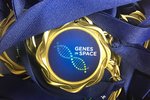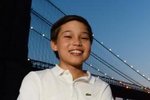GiS Spotlight: Junior Scientist Award winners Achyuta, Kai, and Cole
The Junior Scientist Award recognizes the top 5 outstanding submissions from middle school teams. Today, we'll hear from 2019 Junior Scientist Award winners Achyuta Rajaram (13), Kai Sikora (13), and Cole Bulger (13), who worked with mentor Nitzan Resnick at The Sage School in Foxboro, Massachusetts, to develop their proposal. They share a look inside their winning submission and share advice for future Genes in Space participants.
Briefly explain your experiment: One of the major risk factors for melanoma, a cancer of skin cells, is ultraviolet radiation. We wanted to test if melanoma is also induced by cosmic rays, and if this is the case, what would be some materials that can protect against the effect of cosmic rays? We specifically looked at the V600E mutation of the BRAF gene to see if cosmic radiation increases the number of V600E and how various parts of the ISS, including the outside walls and the astronaut suits, protect the ISS’s inhabitants from the mutation.
Why did you choose to participate in Genes in Space? We chose to participate in Genes in Space because we are all interested in science and this is a very unique opportunity. We have a diverse STEM/STEAM program at our school, which introduces us to timely and relevant topics, in class and in practice. We all enjoy material engineering, which inspired our research into radiation protection. Seeing as space is so unexplored and vast, it was very fun to think of an innovative and new idea. We also found the ability to positively impact the lives of the astronauts aboard the ISS alluring and wanted to use this experiment to help them by determining an effect of cosmic radiation
How did you choose your topic? We started our journey on two websites - those of Genes in Space and NASA. We read and watched videos of past projects, the experimental procedures that can be executed on ISS, and to understand how the PCR works. We then narrowed it down, determining that we wanted to look at the protection of melanoma. We chose melanoma as our topic because melanoma is a potentially deadly form of cancer that can be aggravated by radiation. Afterward, we found a specific gene and mutation that we determined had a great effect. Our interest in engineering pertained to the idea that even if cosmic rays increase the rate of mutation of BRAF, we might be able to protect the astronauts, by choosing specific materials for the space lab and for the astronaut's gear, which block the effect of the radiation.
What did you gain by participating in Genes in Space? Genes in Space gave us a renewed interest in space science, and an opportunity to collaborate with our peers on an interesting and innovative project. We had to work together as a team and manage our time to complete this project. We learned a lot about the ISS and the equipment on board it while creating our project, as we had to make sure the astronauts aboard the ISS could complete the experiment without needing new lab equipment, which could cost millions of dollars to send into space. We also learned a lot about genetics and molecular biology techniques in our study of melanoma.
Do you have any advice for future Genes in Space contestants? Make sure you find a project you’re really passionate about. If you’re passionate about your project, whether it be about mitochondria or food availability in space, you will learn new topics, new techniques and enjoy the process!


